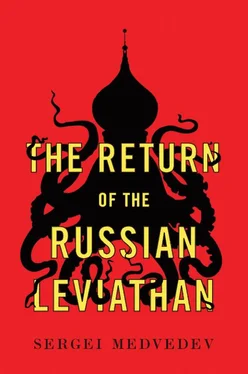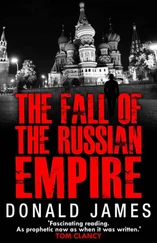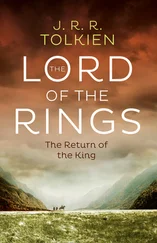Exactly the same thing happened when the Russian Security Council discussed the fantasy threat that Russia might be excluded from the worldwide web (as happened to Sudan in 2007). This was a purely commercial idea, dreamt up in order to sell to the state equipment that would duplicate the infrastructure of the Internet in Russia. The threat of Russia being excluded from the worldwide web remains purely hypothetical; but real funds can be allocated to that idea – including technology costing hundreds of millions of dollars. A very peculiar ‘threat market’ is growing in modern Russia, and bets on this are constantly growing. As for the growth in the amount of resources that are redistributed, there is ‘threat inflation’, as new ones are constantly being brought into being. Threats may be genuine or just as easily imagined or carefully designed. The motivation of the players in this market may be purely for their own department, or it may be commercial (frequently these amount to the same thing), but the sale of these threats has massive internal and foreign policy consequences.
The emergence of this market has been dictated by the character of the political elite of Putin’s third term. In place of ‘Politburo 2.0’, which was made up of representatives of the power ministries ( siloviki ), bureaucrats and oligarchs, the leadership is now totally dominated by the siloviki . As the political commentator Konstantin Gaaze writes, all the key decisions in the past year have been taken by a closed circle of representatives of the FSB. ‘The FSB doesn’t concern itself with development, it just reacts to threats as it sees them. The government and the various departments spend years weighing up the pros and cons of any decision, but now the FSB simply “sells” a threat to the President and he immediately takes the decision reached by the Service.’ In this way, according to Gaaze, the decision was taken about protecting Russians’ personal data (according to which all personal data should be stored on Russian servers); about the embargo on foodstuffs; and also about many questions linked to Ukraine.
The threat-producing machine works on the redistribution of state resources to the advantage of the power corporations and the business structures linked to them. Here you will find means that have been earmarked for the rebuilding of Crimea and the war with Ukraine, the rearmament of the Russian Army and the modernization of the nuclear arsenal. Then there’s the expensive reinvention of the bicycle – that is, the production of Russian versions of global technology: GLONASS instead of GPS; a sovereign Internet on local servers; a national payment system, ‘Mir’, in place of Visa or MasterCard; and a national search engine, ‘Sputnik’, to take the place of Google. Fascinated by imaginary threats, the Kremlin has diverted funds from the market to the siloviki , who follow their own commercial interests exclusively through nonmarket methods. The liberals in the system have been crushed; those that are left carry out rearguard battles in the Central Bank; and market logic no longer works in post-Crimea Russia.
But this is just half the problem. The bitter irony is that the idea is tangible, and these threats, which were dreamt up and sold to the Kremlin, have become reality – only now not as the reasons for Russian policy, but as the results of this policy. The Kremlin is not reacting to threats, but creating them itself. So in the autumn of 2013, for instance, the legend was dreamt up about ‘the loss of Ukraine’ if it were to sign an Association Agreement with the EU. In many ways this Agreement was a mere formality and did not carry with it any obligations. But because of this, the Kremlin started to tie the hands of the then Ukrainian President, Viktor Yanukovych, which led to mass demonstrations on Kiev’s Maidan Square and subsequently the whole spiral of confrontation. As a result, Ukraine went ahead and signed the Agreement; and is now lost to Russia forever. Three months later, in February 2014, the annexation of Crimea was undertaken out of fear of an imaginary ‘NATO base in Sevastopol’; and what has happened as a result? Ukraine is rapidly growing closer to the North Atlantic Alliance and NATO is expanding its presence by creating permanent bases in the Baltic States, which are worried by the turn of events. In Russia they started battling with imaginary ‘separatists’ until they were foaming at the mouth, and as a result created the virus of separatism, coming to us from Crimea and Donbass.
The problem is that the siloviki , who have a complete hold on power in post-Crimea Russia, are capable of thinking and acting only in a space full of threats. All they can do is track, describe and neutralize threats. This is their particular way of dealing with the outside world, where they see only challenges, not possibilities. The siloviki need threats for bureaucratic domination; for obtaining resources and the redistribution of property. Now, though, the Chekist machinery for replicating threats has become a loose cannon and has started to destroy everything around it. It has itself become a threat to Russia’s national security. ‘The threat period’, which our military teacher frightened us with in my childhood, has finally arrived.
CHURCHILL DREAMT IT ALL UP
There’s a national sport in Russia – and it’s not fishing, or checkers or even hockey. It is exposing global conspiracies. From the false ‘Protocols of the Elders of Zion’ about the establishment of world domination by the Jews, to the ‘Dulles Doctrine’ for the moral degradation of Soviet citizens; from the idea that the October Revolution of 1917 was funded by the German General Staff, to the collapse of the USSR in 1991 being planned by the CIA: everywhere we are looking for the false bottom in the suitcase, for secret signs or interests behind the scenes, and we always ask the question, ‘Who gains from this?’ We are perceptive and vigilant, like the patients in the asylum in Vladimir Vysotsky’s song, which said of the Bermuda Triangle: ‘Churchill dreamt all this up in 1918’. [15] Vladimir Vysotsky was a popular singer of ballads in the 1960s and 1970s whose often humorous songs were regarded as being on the edge of what was acceptable to the Communist leadership. http://vysotskiy-lit.ru/vysotskiy/stihi-varianty/317.htm . Letter to the Editor (in Russian).
Hearing about the terrorist bomb at the finish line of the Boston Marathon on 15 April 2013, our homegrown conspiracy theorists immediately declared it to be a CIA set-up. Bloggers compared photos before and after the explosion and where the policemen were situated and insisted that the wounded could not have been quietly sitting in wheelchairs and that therefore they were simply actors. The television anchor Maxim Shevchenko came right out and said that the scene was part of a secret scenario arranged to cover up the USA’s failed policy in Iraq in order to justify sending American troops into the Caucasus.
Conspiracy theories have always abounded everywhere, but they became particularly popular from the time of the French Revolution, which was said to be either the work of the Masons, or the Illuminati, or the Jews. In America itself there are conspiratorial versions of the murder of President Kennedy; or those that say that the Moon landings were staged on Earth. But wherever they appear, conspiracy theories remain the product of immature or sick minds. In Russia, conspiracy has become the dominant worldview. This can probably be explained historically by the long tradition of a lack of freedom, of serfdom and by the psychology of slavery. Not being responsible for their own fate, people became used to blaming everything that happened on a higher power: the peasantry said it was ‘all due to the nobles’, and the nobles that it was ‘the will of the sovereign’.
Читать дальше












